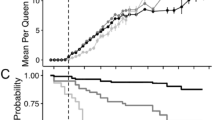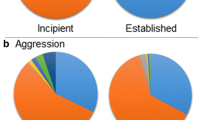Abstract
Within-group conflict may influence the degree to which individuals within a group cooperate. For example, the most dominant individuals within a group often gain access to the best resources and may be less inclined to perform risky tasks. We monitored space use and division of labor among all workers in three colonies of bumblebees, Bombus impatiens, during the ergonomic and queenless phases of their colony cycle. We then measured the two largest oocytes in each worker to estimate each individual's reproductive potential at the end of the colony cycle. We show that workers that remained farther from the queen while inside the nest and avoided risky or more energy-expensive tasks during the ergonomic phase developed larger oocytes by the end of the colony cycle. These individuals also tended to be the largest, oldest workers. After the queen died, these workers were more likely than their nestmates to increase brood incubation. Our results suggest that inactive bumblebees may be storing fat reserves to later develop reproductive organs and that the spatial organization of workers inside the nest, particularly the distance workers maintain from the queen, may predict which individuals will later have the greatest reproductive potential in the colony.





Similar content being viewed by others
References
Alaux C, Jaisson P, Hefetz A (2004) Queen influence on worker reproduction in bumblebees (Bombus terrestris) colonies. Insectes Sociaux 51:287–293
Ayasse M, Marlovits T, Tengö J, Taghizadeh T, Francke W (1995) Are there pheromonal dominance signals in the bumblebee Bombus hypnorum L. (Hymenoptera, Apidae)? Apidologie 26:163–180
Bloch G, Hefetz A (1999a) Reevaluation of the role of mandibular glands in regulation of reproduction in bumblebee colonies. J Chem Ecol 25:881–896
Bloch G, Hefetz A (1999b) Regulation of reproduction by dominant workers in bumblebee (Bombus terrestris) queenright colonies. Behav Ecol Sociobiol 45:125–135
Bourke AFG (1994) Worker matricide in social bees and wasps. J Theor Biol 167:283–292
Bourke AFG, Ratnieks FLW (1999) Kin conflict over caste determination in social Hymenoptera. Behav Ecol Sociobiol 46:287–297
Bridge C, Field J (2007) Queuing for dominance: gerontocracy and queue-jumping in the hover wasp Liostenogaster flavolineata. Behav Ecol Sociobiol 61:1253–1259
Cameron SA (1989) Temporal patterns of division of labor among workers in the primitively eusocial bumble bee, Bombus griseocollis (Hymenoptera: Apidae). Ethology 80:137–151
Cant MA, Field J (2001) Helping effort and future fitness in cooperative animal societies. Proc R Soc Lond B 268:1959–1964
Cant MA, Field J (2005) Helping effort in a dominance hierarchy. Behav Ecol 16:708–715
Clémencet J, Rome Q, Fédérici P, Doums C (2008) Aggressions and size-related fecundity of queenless workers in the ant Cataglyphis cursor. Naturwissenschaften 95:133–139
Cnaani J, Schmid-Hempel R, Schmidt JO (2002) Colony development, larval development and worker reproduction in Bombus impatiens Cresson. Insectes Sociaux 49:164–170
Cole BJ (1986) The social behavior of Leptothorax allardycei (Hymenoptera, Formicidae): time budgets and the evolution of worker reproduction. Behav Ecol Sociobiol 18:165–173
Couvillon MJ, Dornhaus A (2009) Location, location, location: larvae position inside the nest is correlated with adult body size in worker bumble-bees (Bombus impatiens). Proc R Soc Lond B 276:2411–2418
Cronin AL, Field J (2007) Rank and colony defense against conspecifics in a facultatively eusocial hover wasp. Behav Ecol 18:331–336
Duchateau MJ, Velthuis HHW (1989) Ovarian development and egg laying in workers of Bombus terrestris. Entomologia Experimentalis et Applicata 51:199–213
Fénéron R, Durand J-L, Jaisson P (1996) Relation between behaviour and physiological maturation in a ponerine ant. Behaviour 133:791–806
Foster RL, Brunskill A, Verdirame D, O’Donnell S (2004) Reproductive physiology, dominance interactions, and division of labour among bumble bee workers. Physiological Entomology 29:327–334
Free JB (1955) The behaviour of egg-laying workers of bumblebee colonies. Br J Anim Behav 3:147–153
Geva S, Hartfelder K, Bloch G (2005) Reproductive division of labor, dominance, and ecdysteroid levels in hemolymph and ovary of the bumble bee Bombus terrestris. J Insect Physiol 51:811–823
Goulson D, Peat J, Stout JC, Tucker J, Darvill B, Derwent LC, Hughes WOH (2002) Can alloethism in workers of the bumblebee, Bombus terrestris, be explained in terms of foraging efficiency? Anim Behav 64:123–130
Hamilton WD (1971) Geometry for the selfish herd. J Theor Biol 31:295–311
Hemelrijk CK (2000) Towards the integration of social dominance and spatial structure. Anim Behav 59:1035–1048
Hemelrijk CK (2002) Understanding social behaviour with the help of complexity science. Ethology 108:655–671
Human H, Nicolson SW, Dietemann V (2006) Do honeybees, Apis mellifera scutellata, regulate humidity in their nest? Naturwissenschaften 93:397–401
Jandt JM, Dornhaus A (2009) Spatial organization and division of labour in the bumblebee Bombus impatiens. Anim Behav 77:641–651
Jandt JM, Huang E, Dornhaus A (2009) Weak specialization of workers inside a bumble bee (Bombus impatiens) nest. Behavioral Ecology and Sociobiology 63:1829–1836
Judd TM (2000) Division of labour in colony defence against vertebrate predators by the social wasp Polistes fuscatus. Anim Behav 60:55–61
Keller L, Nonacs P (1993) The role of queen pheromones in social insects: queen control or queen signal? Anim Behav 45:787–794
Korb J (2003) Thermoregulation and ventilation of termite mounds. Naturwissenschaften 90:212–219
Korb J, Schmidinger S (2004) Help or disperse? Cooperation in termites influenced by food conditions. Behav Ecol Sociobiol 56:89–95
Lin H, Winston ML, Haunderland NH, Slessor KN (1999) Influence of age and population size on ovarian development, and of trophallaxis on ovarian development and vitellogenin titres of queenless worker honey bee (Hymenoptera: Apidae). The Canadian Entomologist 131:695–706
Maynard Smith J, Szathmáry E (1995) The major transitions in evolution. W.H. Freeman, Oxford
Molina Y, O’Donnell S (2009) Worker reproductive competition affects division of labor in a primitively social paperwasp (Polistes instabilis). Insectes Sociaux 56:14–20
O’Donnell S (2001) Worker age, ovary development, and temporal polyethism in the swarm-founding wasp Polybia occidentalis (Hymenoptera: Vespidae). J Insect Behav 14:201–213
O’Donnell S, Jeanne RL (1995) Implications of senescence patterns for the evolution of age polyethism in eusocial insects. Behav Ecol 6:269–273
O’Donnell S, Reichardt M, Foster R (2000) Individual and colony factors in bumble bee division of labor (Bombus bifarius nearcticus Handl; Hymenoptera, Apidae). Insectes Sociaux 47:164–170
Payne CM, Laverty TM, Lachance MA (2003) The frequency of multiple paternity in bumble bee (Bombus) colonies based on microsatellite DNA at the B10 locus. Insectes Sociaux 50:375–378
Pepper JW, Herron MD (2008) Does biology need an organism concept? Biol Rev 83:621–627
Porter SD, Jorgensen CD (1981) Foragers of the harvester ant, Pogonomyrmex owyheei: a disposable caste? Behav Ecol Sociobiol 9:247–256
Powell S, Tschinkel WR (1999) Ritualized conflict in Odontomachus brunneus and the generation of interaction-based task allocation: a new organizational mechanism in ants. Anim Behav 58:965–972
Ratnieks FLW, Reeve HK (1992) Conflict in single-queen hymenopteran societies: the structure of conflict and processes that reduce conflict in advanced eusocial species. J Theor Biol 158:33–65
Ratnieks FLW, Wenseleers T (2008) Altruism in insect societies and beyond: voluntary or enforced? Trends Ecol Evol 23:45–52
Ratnieks FLW, Foster KR, Wenseleers T (2006) Conflict resolution in insect societies. Annu Rev Entomol 51:581–608
Robson SKA, Bean K, Hansen J, Norling K, Rowe RJ, White D (2000) Social and spatial organisation in colonies of a primitively eusocial wasp, Ropalidia revolutionalis (de Saussure) (Hymenoptera: Vespidae). Aust J Entomol 39:20–24
Seeley TD (1982) Adaptive significance of the age polyethism schedule in honeybee colonies. Behav Ecol Sociobiol 11:287–293
Sendova-Franks AB, Franks NR (1995) Spatial relationships within nests of the ant Leptothorax unifasciatus (Latr.) and their implications for the division of labour. Anim Behav 50:121–136
Sokal R, Rohlf FJ (1995) Biometry, 3rd edn. W.H. Freeman, New York
Sramkova A, Schulz C, Twele R, Francke W, Ayasse M (2008) Fertility signals in the bumblebee Bombus terrestris (Hymenoptera: Apidae). Naturwissenschaften 95:515–522
Tindo M, Dejean A (2000) Dominance hierarchy in colonies of Belonogaster juncea juncea (Vespidae, Polistinae). Insectes Sociaux 47:158–163
Tofilski A (2002) Influence of age polyethism on longevity of workers in social insects. Behav Ecol Sociobiol 51:234–237
Tsuji K, Tsuji N (2005) Why is dominance hierarchy age-related in social insects? The relative longevity hypothesis. Behav Ecol Sociobiol 58:517–526
van Doorn A, Heringa J (1986) The ontogeny of a dominance hierarchy in colonies of the bumblebee Bombus terrestris (Hymenoptera, Apidae). Insectes Sociaux 33:3–25
Wenseleers T, Ratnieks FLW (2006) Enforced altruism in insect societies. Nature 444:50
Wenseleers T, Helanterä H, Hart A, Ratnieks FLW (2004) Worker reproduction and policing in insect societies: an ESS analysis. J Evol Biol 17:1035–1047
West-Eberhard MJ (1969) The social biology of Polistine wasps. Miscellaneous Publications, Museum of Zoology, University of Michigan 140:1–101
West-Eberhard MJ (1981) Intragroup selection and the evolution of insect societies. In: Alexander RD, Tinkle DW (eds) Natural selection and social behavior. Chiron, New York, pp 3–17
Woyciechowski M, Kozłowski J (1998) Division of labor by division of risk according to worker life expectancy in the honey bee (Apis mellifera L.). Apidologie 29:191–205
Yerushalmi S, Bodenhaimer S, Bloch G (2006) Developmentally determined attenuation in circadian rhythms links chronobiology to social organization in bees. J Exp Biol 209:1044–1051
Acknowledgments
We thank Nicolas Skye Robbins, Eden Huang, Amanda Barth, and Wendy Isner for their help in data collection, bumblebee dissections, and assistance with bumblebee maintenance. Margaret Couvillon, Scott Powell, and Aimee Dunlap provided feedback on the manuscript and statistical analyses. We also thank Laurent Keller and two anonymous reviewers for their detailed comments and suggestions. Research supported through the College of Science, Department of Ecology & Evolutionary Biology, University of Arizona, and NSF grant to AD (grant no. IOS 0841756).
Author information
Authors and Affiliations
Corresponding author
Additional information
Communicated by L. Keller
Rights and permissions
About this article
Cite this article
Jandt, J.M., Dornhaus, A. Competition and cooperation: bumblebee spatial organization and division of labor may affect worker reproduction late in life. Behav Ecol Sociobiol 65, 2341–2349 (2011). https://doi.org/10.1007/s00265-011-1244-9
Received:
Revised:
Accepted:
Published:
Issue Date:
DOI: https://doi.org/10.1007/s00265-011-1244-9




